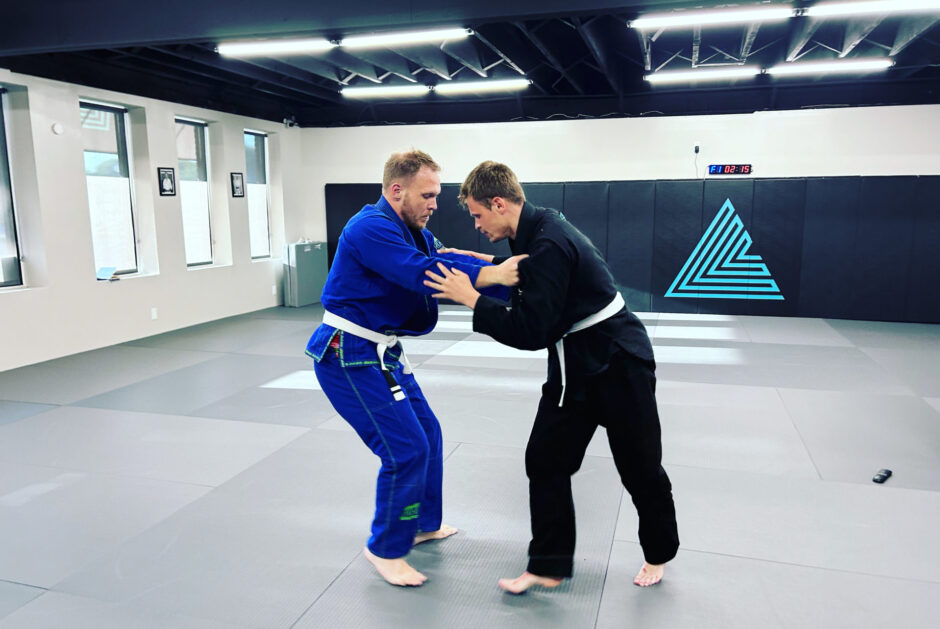Understanding constraints-led training
The constraints-led approach (CLA) is a training method that focuses on manipulating conditions such as task focuses and constraints while playing “small-sided” games to develop skills in training. Based in ecological psychology and dynamical systems theory, the constraints-led method harnesses the idea of direct perception to enhance skill development by directing athlete focus into the environment to harness the information it provides in deciding how to react effectively and efficiently.
In the context of Brazilian Jiu-Jitsu (BJJ), adopting a CLA means deliberately adding specific limitations or challenges to training sessions to improve skills and problem-solving abilities. By placing constraints on certain behaviors, practitioners are forced to adapt and develop new strategies, ultimately leading to better overall performance in BJJ.

Benefits of constraints-led training in BJJ
Constraints-led training in BJJ can enhance a practitioner’s skills by forcing them to adapt to different situations and problems. It promotes creativity and problem-solving by placing restrictions on certain movement solutions (techniques), making the practitioner think on their feet to adapt new solutions. This also helps improve their decision-making under pressure, ultimately making them a more versatile and flexible grappler.
Key principles of constraints-led BJJ training
Constraints-led BJJ training focuses on creating specific challenges that encourage the practitioner to develop highly adjustable and flexible skills. A CLA emphasizes problem-solving, creativity, and adaptive thinking in training. The main principles harnessed in a CLA include task specificity, modifying the performance environment, and constraining behaviors to help practitioners zero in on specific information in the performance environment they can act on to develop skillful behavior.
A CLA encourages a more dynamic and adaptive training environment, challenging athletes to think critically and creatively during practice sessions. Because all learning is done against live resistance, practitioners learn all skills in the context of resistance and defensive or offensive tactics. This builds skills that are stronger and more robust.
Overcoming limitations through constraints-led training
Constraints-led training helps practitioners push past their limits, break attractor states (behavioral habits), and develop new and unique ways to solve problems. By focusing on the invariant concepts (things that don’t change from person to person, situation to situation) of jiu-jitsu, it can help jiu-jitsu practitioners become immune to the novelty of ever-evolving new techniques in the art and sport.
A CLA focuses on problem-solving and encourages individuals to explore different strategies to achieve their goals effectively.
Designing effective drills for constraints-led BJJ training
Drills in constraints-led BJJ training should be purposeful and specific to help you improve. Focus on creating games that replicate real situations the athlete may encounter in a match. It’s essential to emphasize adaptability and decision-making under pressure in training. Effective game design harnesses the following:
- Simplifie complex movements to focus on key principles
- Tells athletes what to accomplish using clear, concise language within task focuses.
- Creates scenarios that limit some options to force creativity and problem-solving.
- Encourages variability and experimentation to develop a versatile game that is immune to novelty.
- Keep tasks and constraints challenging yet achievable to enhance athlete skill development effectively.
Consistency and progression in constraints-led BJJ training
Tracking progress and setting achievable goals play a fundamental role in advancing skills within a CLA. By setting up good systems to measure progress, athletes can more effectively see the effects of various constraints and task focuses.
Good CLA coaches are adept at meeting the learner where they currently are in their progression and designing games and tasks that will help that learner hone in on skills they are lacking.
How constraints-led training enhances problem-solving skills in BJJ
When practicing BJJ using a CLA, practitioners are presented with specific challenges that require creative problem-solving. These constraints and task focuses push athletes to think outside the box, adapt quickly, and develop new strategies on the mat.
By facing unique challenges, practitioners can engage in “repetition without repetition” to enhance their problem-solving skills, leading to improved decision-making during sparring sessions and competitions.
Unlocking potential with constraints-led approach in BJJ
To unleash a practitioner’s full potential in Brazilian Jiu-Jitsu (BJJ), incorporating a constraints-led approach can be a game-changer. CLA focuses on manipulating the constraints or conditions of the training environment to enhance skills and hone in on skillful behavior.
By setting specific limitations or challenges during practice, such as restricting specific movement solutions, coaches can sharpen problem-solving abilities, creativity, and adaptability on the mat. Constraints-led training encourages practitioners to think outside the box, fostering a deeper understanding of techniques and strategies in BJJ.
Most importantly, A CLA is aligned with the latest science on how organisms interact with their environments. This means practitioners go further faster in their training!
